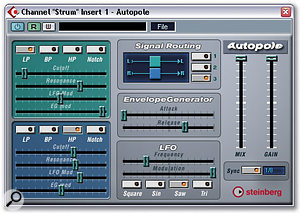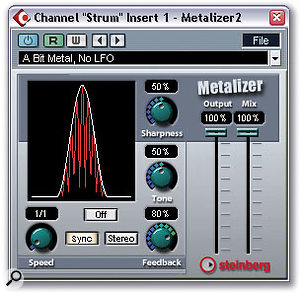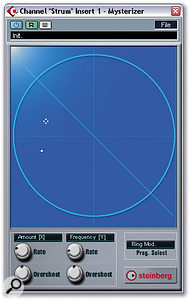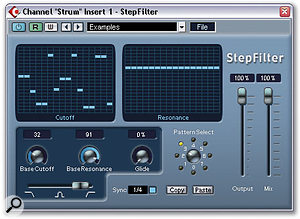 Emagic Logic's most creative filter plug-ins are Autofilter, Denoiser, and the sophisticated Spectral Gate.
Emagic Logic's most creative filter plug-ins are Autofilter, Denoiser, and the sophisticated Spectral Gate.
Filters are at the heart of many of the weirder sequencer plug-ins, so here we check out what each one has to offer, and how you can get weird and wonderful sounds for your mixes.
A large number of effects plug-ins are based around filters, some of which are simple resonant high-pass, band-pass or low-pass filters, while others are far more complicated. The operation of basic resonant synth filters has been covered in depth on many occasions, so I won't go into too much depth other than to say that their sound is dictated not only by the filter type, but also by its slope, expressed in decibels per octave. If the plug-in is attempting to emulate the sound of a particular model of synthesizer, the distortion and other imperfections of the original may also be modelled.
More advanced effects may be created by splitting the audio into a very large number of separate frequency bands, allowing each band's level to be controlled independently. Such a filter is at the heart of every vocoder, and although analogue vocoders may have been limited to as little as a dozen bands, their digital counterparts can work with hundreds of bands if necessary. A vocoder is really a filter bank controlled by a spectrum analyser, which allows the frequency curve of one sound to be imposed on another, hence its ability to create the familiar 'talking synth' effect. Similar filter banks are used in denoising plug-ins, which you can think of as having a separate expander in series with every band, so that when the energy in any band falls below the noise threshold that band is silenced. This approach allows signals to be cleaned up with far fewer side effects than using conventional full-band gates or expanders.
The multi-band filter may also be used to create other effects, and one modern refinement on the vocoder principle is the fingerprint EQ. Whereas the vocoder constantly changes its filter levels depending on the modulator input signal spectrum, a fingerprint EQ measures the average frequency spectrum of two signals over a period of time, then creates a filter setting that will adjust the audio spectrum of one of the parts to exactly match the other. This technique is often used to try to make one mix sound more like another or to match the sounds of two different instrument recordings. The same technique also forms the basis of those plug-ins that attempt to model the characteristics of loudspeakers and microphones.
In addition to these very 'rational' applications for filter banks, it is also possible to modulate or otherwise process the various frequency band levels in different ways to create unusual, often unnatural-sounding effects. For example, the Native Instruments Spektral Delay plug-in allows different bands or groups of bands to be delayed by different amounts, creating interesting time-smearing effects.
Creative Filter Plug-ins In Digidesign Pro Tools
Although there are plenty of interesting and creative third-party filter plug-ins available for Pro Tools, the default Digirack plug-in collection doesn't include any.
If you're feeling left out and you feel the need to add creative filtering to your Pro Tools effects repertoire, some possibilities to investigate include McDSP's Filter Bank (TDM and HD only), GRM Tools (available in both TDM/HD and RTAS formats), the Access Virus TDM synth (which allows you to route audio through its filter section), DUY's DSpider TDM/HD-only effects construction kit, Ohm Force's HTDM/RTAS Frohmage, Sound Toys' HTDM/RTAS Filter Freak, Bomb Factory's TDM/HD-only Moogerfooger Low-pass Filter emulation and Cycling 74's HTDM/RTAS Pluggo plug-in suite. Sam Inglis
Creative Filter Plug-ins In Emagic Logic
Emagic's Logic doesn't have so many creative filter plug-ins as some of its counterparts, but if weirdness is your thing then be sure to check out the Spectral Gate plug-in (shown above). However, you'd be well advised to first read the description in the Help file, as this plug-in may not make much sense without it and quite possibly only a little more with it! Rather than turn signals on or off as a conventional gate does, Spectral Gate appears to combine filtering and multi-band gating. The processing is based on Fourier Transforms, which in this application means converting a signal from the time domain into the frequency domain, then doing something to it before returning it to the time domain. Consequently, all the effects are dramatically spectral in nature.
The frequency range you want to work on is set using the Centre Frequency and Bandwidth controls, and the Threshold control then seems to operate a multi-band gate within it. Audio above this threshold in each of the gate's internal bands can be mixed in using the Super Energy knob, while audio below the gating threshold in each band is mixed in with the Sub Energy knob. The low- and high-frequency components of the original signal, outside the multi-band gate's active range, can also be mixed in independently. The Gain slider sets the level of the effect components, and an LFO section allows the Centre Frequency and Bandwidth controls to be modulated.
 If this makes about as much sense as a Swahili self-assessment tax form covered in Marmite, that's because the technicalities of the processing are very complex and all you can really hope to do is twiddle the knobs to see what comes out! Expect dramatic and often disturbing filter effects and you won't be disappointed.
If this makes about as much sense as a Swahili self-assessment tax form covered in Marmite, that's because the technicalities of the processing are very complex and all you can really hope to do is twiddle the knobs to see what comes out! Expect dramatic and often disturbing filter effects and you won't be disappointed.
Autofilter (see screen shot earlier) is based on a resonant low-pass filter with a choice of slopes and some neat distortion options, controlled by both an envelope generator and an LFO. Both of these modulation sources can be triggered by the input signal, and the triggering threshold can be adjusted by the user. The LFO produces all the usual modulation waveforms, including random sample and hold, and, when the plug-in is used in stereo, the phases of the LFOs controlling each side can be offset to produce more overtly stereo effects. The envelope generator is fairly sophisticated, with full ADSR control as well as a slider for Modulation percentage. This plug-in is useful for adding synth-like filter effects to instruments. However, for consistent triggering, the input needs to be mono, with well defined and separate note attacks.
 The Metalizer and Autopole plug-ins in Steinberg Cubase SX offer a variety of traditional filtering effects, but also provide a lot of scope for experimentation.After the strangeness of Spectral Gate and the neat packaging of existing filter technologies that is Autofilter, Logic also offers a Denoiser based on multi-band filtering. Most advanced denoisers (other than those that are so smart they don't need to know anything!) rely on taking a noise-only fingerprint from part of the recording and then using this to set the thresholds of the expanders in all the frequency bands, but Logic's plug-in is rather simpler and lacks this refinement. A single Threshold control is adjusted during a noise-only or very low-level section to establish the level below which the signal will be considered to be noise, while the Reduce control determines the amount of attenuation applied to signals falling below the threshold. The system assumes either white or pink noise characteristics, with a slider to vary the response from one to the other.
The Metalizer and Autopole plug-ins in Steinberg Cubase SX offer a variety of traditional filtering effects, but also provide a lot of scope for experimentation.After the strangeness of Spectral Gate and the neat packaging of existing filter technologies that is Autofilter, Logic also offers a Denoiser based on multi-band filtering. Most advanced denoisers (other than those that are so smart they don't need to know anything!) rely on taking a noise-only fingerprint from part of the recording and then using this to set the thresholds of the expanders in all the frequency bands, but Logic's plug-in is rather simpler and lacks this refinement. A single Threshold control is adjusted during a noise-only or very low-level section to establish the level below which the signal will be considered to be noise, while the Reduce control determines the amount of attenuation applied to signals falling below the threshold. The system assumes either white or pink noise characteristics, with a slider to vary the response from one to the other.
Because the effect of the filters opening and closing can be very obvious (it sounds like chirping), the user can invoke Time Smoothing, Frequency Smoothing and Transition Smoothing to try to minimise this. Time Smoothing adjusts the response time of the denoising process, while Frequency smoothing forces those frequency bands near to the one closing also to change in level. The description of how Transition Level smoothing works makes no sense at all to me, but its intention is again to reduce chirping. While Denoiser is useful on signals such as electric guitar or noisy synths, I've found it to be too simple to be very useful on complete mixes, as it's very difficult to hide the processing side-effects.
Creative Filter Plug-ins In MOTU Digital Performer
 Digital Performer has only one filter plug-in: Multimode Filter. In most respects this emulates a conventional VCF design, as might be found on a modern analogue modelling synth, for example. However, it has a built-in LFO with variable rate and phase, which can also be synced to DP's metronome, and an envelope triggered either by the input signal or by audio routed into the plug-in via DP's buss architecture.
Digital Performer has only one filter plug-in: Multimode Filter. In most respects this emulates a conventional VCF design, as might be found on a modern analogue modelling synth, for example. However, it has a built-in LFO with variable rate and phase, which can also be synced to DP's metronome, and an envelope triggered either by the input signal or by audio routed into the plug-in via DP's buss architecture.
Deselecting L/R In Phase causes the plug-in to treat the two channels of a stereo signal separately when LFO modulation is selected, so that when the filter on the left channel is closed, the one on the right is open, and so on. It's quite a psychedelic effect, but probably best used sparingly. Multimode Filter also has a MIDI input option — the MIDI note number is used to set the position of the Centre control (which can be thought of as a conventional cutoff control when the plug-in is in low- or high-pass modes), so it's possible to 'play' the filter in real-time. Robin Bigwood
Creative Filter Plug-ins In Steinberg Cubase SX
Although Steinberg Cubase users may covet the EQ and reverb plug-ins bundled with Logic, when it comes to exotic filters Cubase SX and Cubase VST v5 leave their competitors standing, especially since Cakewalk Sonar 2 and Digidesign Pro Tools include none at all in this particular category. This is largely due to a timely influx of talent from FXpansion's Angus Hewlett and MDA's Paul Kellett, whose combined licensed contributions boosted the Cubase VST v5 plug-in effects bundle considerably. I won't attempt to separate out the various contributions from Cubase VST and Cubase SX on this occasion, since in this category they can be particularly confusing — for instance, in the Cubase VST v5 folder you can find Metalizer 2 v1.1 and dated 2000, while Metalizer v1.0 is in the Cubase SX Modulation folder dated 2002. If you do find such duplications, it's always best to use the newest dated version.
Metalizer (see above) is an interesting combination of band-pass filter, with variable sharpness (Q) and optional tempo-sync'ed LFO to sweep the frequency, and a feedback control with both frequency and level controls that provides the titular metallic results. It can produce plenty of unsubtle Cylon-type sounds and comb-filtering, but its most useful contribution is a wide range of traditional wah-wah effects with optional stereo movement between channels, although it can also be coaxed into producing unusual EQ effects with lower settings of its Mix control.
 Cubase SX's Mysterizer plug-in shines not because of any especially inventive filtering algorithms, but because of the novel method by which you can control them.Autopole (shown above) is an unusual combination of two multi-mode filters, each with low-pass, band-pass, high-pass, and notch mode options that can be routed in series, in parallel (one for each stereo channel), or both channels through each filter. These combinations let you set up unusual overall filter shapes, but it's the modulation options that bring Autopole to life, since both an LFO and an envelope generator can be independently applied in positive or negative directions to each filter. The LFO waveform can also be retriggered according to five tempo sync options. I've used Autopole to create complex animation in riffs with a low-pass triggered envelope on the left and fast tempo-sync'ed LFO-swept high-pass filter on the other. Autopole is extremely versatile if you've got plenty of patience, although it's a shame you can't easily balance the two filter output levels in parallel mode.
Cubase SX's Mysterizer plug-in shines not because of any especially inventive filtering algorithms, but because of the novel method by which you can control them.Autopole (shown above) is an unusual combination of two multi-mode filters, each with low-pass, band-pass, high-pass, and notch mode options that can be routed in series, in parallel (one for each stereo channel), or both channels through each filter. These combinations let you set up unusual overall filter shapes, but it's the modulation options that bring Autopole to life, since both an LFO and an envelope generator can be independently applied in positive or negative directions to each filter. The LFO waveform can also be retriggered according to five tempo sync options. I've used Autopole to create complex animation in riffs with a low-pass triggered envelope on the left and fast tempo-sync'ed LFO-swept high-pass filter on the other. Autopole is extremely versatile if you've got plenty of patience, although it's a shame you can't easily balance the two filter output levels in parallel mode.
Mysterizer starts with a fairly straightforward choice of effects (ring modulation, three types of delay, three types of filter, plus distortion), but it's the control method that turns it into a tour de force — the X-Y mouse control surface automates two parameters with Newtonian ballistics. If you want to smooth out the jerkiness of your mouse movements, use a slower Rate, while the Overshoot controls the amount of 'bounciness' — with the benefit of automation you can add a lot of human feel to a song after some practice.
 MIDI Comb is another FXpansion creation, this time using very short delays to create a series of comb-filters with resonant peaks at different frequencies. Rather than modulate these frequencies using an LFO, far more flexibility is provided by MIDI control, which requires a separate MIDI track to be set up. You just use the MIDI Comb as an Insert effect in your audio track, create a suitable MIDI track and select MIDI Comb for its output, and then start playing your music keyboard with up to eight-note polyphony, each MIDI note generating a resonant tone of a different pitch.
MIDI Comb is another FXpansion creation, this time using very short delays to create a series of comb-filters with resonant peaks at different frequencies. Rather than modulate these frequencies using an LFO, far more flexibility is provided by MIDI control, which requires a separate MIDI track to be set up. You just use the MIDI Comb as an Insert effect in your audio track, create a suitable MIDI track and select MIDI Comb for its output, and then start playing your music keyboard with up to eight-note polyphony, each MIDI note generating a resonant tone of a different pitch.
Each resonant tone has its own Attack/Release envelope, and provides velocity control of its Level, Resonance, High-pass, and Low-pass filter frequencies, in either positive or negative directions, for more expression. There are also global controls for the low-pass and high-pass cutoff frequencies, which change overall tonal colour, plus an overall feedback control to provide stronger resonances. MIDI Comb doesn't provide instant gratification, but the patient experimenter will eventually be rewarded with some most unusual results. With high attack and release settings and the Mix control set to its mid-position, I've used it to add slowly swelling overtones to guitar and string tracks, while whacking up the feedback and pulling the mix to maximum lets you play chords over ghostly bowed string clusters. File under weird but occasionally wonderful!
 The Vocoder and Stepfilter plug-ins allow some of the more interesting filter-based effects in Cubase SX.The Vocoder is a Paul Kellett creation, which as described in the introduction lets you apply the frequency response of one sound to another. It provides far too many controls for me to explain individually, but provides two main modes of operation — MIDI and External. MIDI mode uses the built-in polyphonic synth as the carrier signal, and you set it up exactly like MIDI Comb, using the Vocoder as an insert effect with the track you want modulated, and creating a separate MIDI track whose output is set to Vocoder to either play it in real time or from recorded data. Alternatively, External mode places the carrier signal on the right and the modulator on the left of a stereo audio track, and is more easily used with a Group channel so you can employ two separate mono tracks — this is the way to proceed if you want talking instruments. The number of frequency bands can range from two to 24, and the 16 presets demonstrate the possibilities very well, with sounds ranging from early Bell Labs instruments using only 10 bands, to smoother, more modern results with 24 bands, plus ethereal breathy pads and moody resonators.
The Vocoder and Stepfilter plug-ins allow some of the more interesting filter-based effects in Cubase SX.The Vocoder is a Paul Kellett creation, which as described in the introduction lets you apply the frequency response of one sound to another. It provides far too many controls for me to explain individually, but provides two main modes of operation — MIDI and External. MIDI mode uses the built-in polyphonic synth as the carrier signal, and you set it up exactly like MIDI Comb, using the Vocoder as an insert effect with the track you want modulated, and creating a separate MIDI track whose output is set to Vocoder to either play it in real time or from recorded data. Alternatively, External mode places the carrier signal on the right and the modulator on the left of a stereo audio track, and is more easily used with a Group channel so you can employ two separate mono tracks — this is the way to proceed if you want talking instruments. The number of frequency bands can range from two to 24, and the 16 presets demonstrate the possibilities very well, with sounds ranging from early Bell Labs instruments using only 10 bands, to smoother, more modern results with 24 bands, plus ethereal breathy pads and moody resonators.
Finally, FXpansion's Phatsync is a 'pattern-controlled multi-mode filter' with tempo sync, which also appears as Stepfilter with improved graphics and sixteen instead of four sync options in Cubase SX. You can mix continuously between the three filter mode outputs (low-pass, band-pass, and high-pass) using the mode control, and set the Base Cutoff frequency and Bass Resonance controls before creating two 16-step grid patterns, in windows labelled Cutoff and Resonance, which modulate these base control values. A Glide control provides portamento between the individual steps, and up to eight pattern memories can be saved with each preset and called up via a rotary control. Pattern cut and paste controls let you quickly create variations on an existing theme. Usefully, the Cubase SX Stepfilter version also lets you click on any of the eight pattern LEDs to instantly jump between them, which is great for real-time performance. StepFilter patterns can be fiddly to set up initially due to the sometimes tiny mouse movements required, but the results are worth it, ranging from slow sweeps to intricate motifs featuring hops, skips, and jumps — you can also create mini-riffs by emphasising particular beats with high resonance values to create pseudo-drum and hi-hat sounds.
